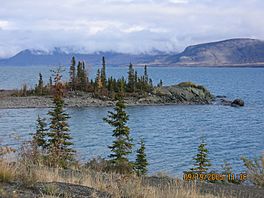Kluane Lake facts for kids
Quick facts for kids Kluane Lake |
|
|---|---|
 |
|
| Location | Yukon |
| Coordinates | 61°14′N 138°40′W / 61.233°N 138.667°W |
| Primary inflows | Formerly the Slims River |
| Primary outflows | Kluane River |
| Catchment area | Bering Sea Watershed |
| Basin countries | Canada |
| Max. length | 81 km (50 mi) |
| Surface area | c. 408 km2 (158 sq mi) |
| Average depth | 31 m (102 ft) |
| Max. depth | 91 m (299 ft) |
| Surface elevation | 781 m (2,562 ft) |
| Settlements | Burwash Landing, Destruction Bay |
Kluane Lake is a very large lake in the southwest part of the Yukon territory in Canada. It is the biggest lake that is completely inside Yukon. The lake is about 408 square kilometers (158 square miles) in size. It stretches for about 81 kilometers (50 miles) long.
Kluane Lake used to get its water from the A'ay Chu, also known as the Slims River. This river was made of melted ice from the Kaskawulsh Glacier. The lake's water then flows into the Kluane River. From there, it travels through other rivers like the Donjek and White Rivers, eventually reaching the huge Yukon River. Finally, all this water ends up in the Bering Sea.
The lake is a great place for fishing. It has many large lake trout and whitefish. Kluane Lake is about 60 kilometers (37 miles) northwest of a town called Haines Junction. The lake is about 31 meters (102 feet) deep on average. At its deepest point, it goes down to 91 meters (299 feet).
You can see amazing views of Kluane Lake if you drive along the Alaska Highway. This highway runs along most of the lake's southern edge.
Towns by Kluane Lake
Two communities are located right on the southern shore of Kluane Lake. These towns are Burwash Landing and Destruction Bay. People live and work in these small towns by the lake.
Animals Living Near the Lake
The area around Kluane Lake is home to special animals. Two groups of caribou live and travel here. These are the Aishihik and Kluane caribou herds. They are a type of northern mountain caribou. This kind of caribou is a unique group of the larger woodland caribou.
In 2009, there were 181 caribou in the Kluane herd. This herd is also known as the Burwash herd. At that time, the Kluane herd was getting smaller. The Aishihik herd had 2044 caribou and was growing.
Images for kids
-
Climate change: Kluane Lake's main tributary (the A'ay Chu, or Slims River) has mostly dried since the retreating Kaskawulsh Glacier's meltwater suddenly diverted in May 2016. Yukon, Canada. 2019 photo by Tom Dempsey / PhotoSeek.com
See also
 In Spanish: Lago Kluane para niños
In Spanish: Lago Kluane para niños






